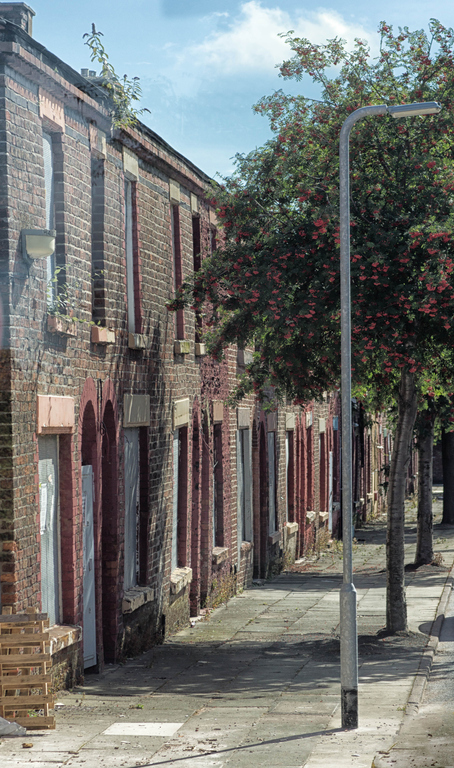Get updates from The Developer straight to your inbox Yes, please!
We can save Britain's heritage and embodied carbon
Politicians keep promising to put heritage at the heart of decision-making and embodied energy makes renewal the obvious choice, writes Judith Martin. Why is the government still keen on destruction?

Taking up her role on 15 September, the first act of Nadine Dorries, Secretary of Secretary for Digital, Culture, Media and Sport (DCMS), was to de-list the Dorman Long tower in Redcar. It was blown up within days.
Dorman Long tower had been listed by Historic England following a community campaign to preserve it. Demolition of the entire British Steel site in Redcar began in August but stopped when campaigners argued that this piece of steelmaking history should be preserved to reflect that Redcar and steel were once synonymous.
A community campaign may seem unusual for a concrete structure, more often threatened by local antipathy and a populist dislike of Brutalist architecture. Only the Twentieth Century Society speaks up for buildings that characterise 20th century Britain, alongside a handful of architects and a certain sort of preservationist.
Every culture secretary promises to put heritage at the heart of decision-making, rarely mentioned is the quantity of embodied energy in these buildings
It took Angela Brady, past president of the RIBA, to save Preston Bus Station from demolition after Preston Council opposed listing. Now it’s a much-loved asset.
Dorries is the tenth Culture Secretary since the Coalition Government took charge in 2010, with every one of them promising to put heritage at the heart of decision-making. Rarely mentioned is the quantity of embodied energy in these buildings. At the time those Brutalist giants were built, one tonne of cement equalled one tonne of CO2.
Rescue and reuse are in the DNA of the heritage sector. In the very early days of the Heritage Lottery Fund (and possibly on a different planet), the DCMS noted that the bricks in a Victorian house contained sufficient energy to drive a car more than ten times around the world. It concluded that it made environmental sense to reuse and refurbish rather than demolish and rebuild.
Then, along came the Housing Market Renewal Pathfinders, a demolition scheme designed to tackle “market failure”, which tore down more than 20,000 homes simply because they were in the wrong place at the wrong time. Launched by deputy prime minister John Prescott in 2002, handsome Victorian villas in Liverpool that would have been worth huge sums in the South were deemed worthless. The tiny, but mightily effective, charity SAVE Britain’s Heritage fought Pathfinder until it was halted in 2011.
Now renewal is something to celebrate. In 2015, Assemble Architects won not the Stirling Prize for architecture, but the Turner Prize for art with their work on Liverpool’s Granby 4 Streets, whose dogged residents had clung on for long enough to be rescued, resisting, in the words of the inestimable Hazel Tilley, being told how they should live.
This year, the heritage sector whooped with glee when Lacaton & Vassal, the architects who “never demolish”, won the 2021 Pritzker Prize – architecture’s highest honour. Commissioned to design a replacement for 530 social-housing apartments in three large blocks in Bordeaux, they transformed them instead, adding balconies and winter gardens.
But that is France. Still, it’s tempting to whip to and fro across La Manche in comparison. Near Barcelona, Ricardo Bofill began his striking conversion of a cement factory called La Fabrica into his home and studio in 1973, more than 30 years before Portsmouth City Council, so thrilled to be demolishing the Tricorn, held a party with fireworks and the 1812 Overture. Pilgrims visit shrines to Le Corbusier in Marseille and Ronchamp, while the religiosi departed St Peter’s Seminary at Cardross, Argyll & Bute not long after it was built, with devotees of the astonishing ruin bereft at the continued lack of support for a rescue mission.
In a recent article published in The Developer, Uma Marman advised Michael Gove on the occasion of him becoming the twelfth housing minister in as many years – now with added Levelling Up. Marman’s advice is so good it should be written in letters across the sky. I would only add to her list a points for both Dorries and Gove to consider regarding heritage in the built environment and embodied carbon.
Cutting VAT would be transformational. Heritage bodies and advocates of reuse have been arguing for years that the playing field is grossly uneven
When Gove was environment minister (for two whole years) he spoke of bees and beavers, both known to be skilled builders, but said nothing about actual buildings for humans.
Construction is the most wasteful industry, consuming about 400m tonnes of material a year and wasting a quarter of them, according to Wrap, the waste watchdog. At the same time, Action on Empty Homes and The Big Issue report that over a quarter of a million homes have been empty for over 6 months. Refurbishing these homes produces nothing but benefit and can be accomplished at all scales, from Lacaton & Vassal-style blocks to small terrace houses.
There are economic benefits to street-by-street refurbishment too, as these works and any infill projects can be carried out by local builders, themselves an endangered species. Employment on site is local, earnings are spent locally, and the bulk of the profits remain, if not in the community, at least in the country. Granby 4 Streets is a Community Land Trust, the most localised system of all
Cutting VAT would be transformational. Heritage bodies and advocates of reuse have been arguing for years that the playing field is grossly uneven. The Architects’ Journal’s RetroFirst campaign has been championing tax reform since 2019. It makes no sense to charge someone 20% tax to mend the roof while allowing developers to demolish or build on a greenfield site and pay nothing. Paying 5% VAT across the board is advocated by just about every heritage body and urban planning academic.
Why hasn’t VAT been cut? Successive governments have blamed the EU, saying they weren’t allowed to. That is not strictly accurate, but in any case, that excuse has gone. There is still no word of levelling the playing field, however, only of the mysterious levelling up.
Some VAT reductions have been introduced for energy improvements, but to call the qualifying system byzantine is to insult a finely run state until the sack of Constantinople. Double glazing and water turbines, for example, attract the full 20% while heat pumps have the reduced rate of 5%, but only for people over 60 or on certain benefits, and then only if the actual kit doesn’t cost more than 60% of the installation. Wood fuelled boilers qualify for the 5% rate, but don’t tell Michael Gove who wants to ban them. And don’t mention the Drax power station either, where the VAT reduction amounts to a daily subsidy of £2m for burning trees.
Why hasn’t VAT been cut? Successive governments have blamed the EU, saying they weren’t allowed to. That is not strictly accurate, but in any case, that excuse has gone.
A policy to prevent wanton demolition would also be a gamechanger, to match the shift in public mood and climate agenda. One of the more bonkers policy recommendations from Oxford University’s Environmental Change Institute in 2005 suggested that in the name of energy-saving, every house built before 1919 should be demolished and replaced. The proposal failed to gain much traction – it’s hard to imagine demolishing the Georgian Terraces of Bath or stuccoed terraces of Belgravia. Yet many London boroughs have jumped at the opportunity to flatten numerous poorly-maintained estates of social housing and replace them with unaffordable housing at greater density.
Some of these estates were funded by Victorian philanthropists, keen to improve the moral and physical welfare of the poor, most were built by the London County Council or its successor the Greater London Council, representing everything Margaret Thatcher despised. The difference in the homes that were demolished and those saved was not the quality of the building.
Thankfully the LCC’s pioneering and glorious Boundary Street is listed. Its brickwork must be worth thousands of car journeys around the world. It hangs on in spite of Right-to-Buy (that Marman rightly says Gove should reconsider).
Sheffield’s Park Hill, listed Grade II*, was rescued at least in part by Urban Splash. The new coloured panels may not be historically accurate, and a swish restored 2-bed flat may sell for £175,000 (while a local 3-bed terrace house can cost half that) but one hell of a lot of embodied energy has been saved, and Sheffield has retained its landmark on the hill.
The GLC estates are far more vulnerable. Southwark’s Heygate Estate is the epitome of bad practice here. Superficially unlovely – that is, Brutalist – it was nonetheless close to the hearts of residents, with its trees and communal space. Its 1,200 flats built to generous Parker-Morris standards were demolished and replaced by Elephant Park, with 2,300 units only a quarter of which are ’affordable’ (which at 80% of market prices, means unaffordable).
To add insult to injury, it was revealed in 2013 that Southwark had sold the site to Lendlease for £50m having spent £44m on demolition and £21m on redevelopment plans. The new homes the tenants were promised had still not been built by the time the tenants were ’decanted’.
The records are silent, as the lawyers say, on whether or not Southwark made any calculations of relative carbon footprints.
As for the ears of politicians, major construction and development companies account for 20% of Conservative party donations. Nothing will improve until party funding and lobbying – already predicted by David Cameron to be the next great scandal – is sorted out. Only then will the scales be rebalanced in favour of society and the environment.
Support The Developer on Patreon
Our journalism has always been free-to-air.
If you value what we publish, be our patron from £3 per month
Sign up to our newsletter
Get updates from The Developer straight to your inbox
Thanks to our organisation members
Become a member
© Festival of Place - Tweak Ltd., 124 City Road, London, EC1V 2NX. Tel: 020 3326 7238

